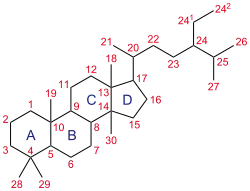

A secosteroid (/ˈsɛkoʊˌstɛrɔɪd/) is a type of steroid with a "broken" ring. The word secosteroid derives from the Latin verb secare meaning "to cut",[2]: 241 and 'steroid'. Secosteroids are alternatively described as a subclass of steroids[3] or derived from steroids.[4]
Types or subclasses of secosteroids are defined by the carbon atoms of the parent steroid skeleton where the ring cleavage has taken place. For example, 9,10-secosteroids derived from cleavage of the bond between carbon atoms C9 and C10 of the steroid B-ring (similarly 5,6-secosteroids, 13,14-steroids, etc.).
The prototypical secosteroid is cholecalciferol (vitamin D3).[5]
Some nonsteroidal estrogens, like doisynolic acid and allenolic acid, are also secosteroids or secosteroid-like compounds.
References
- ↑ "3S-8 and 3S9". qmul.ac.uk.
- ↑ Ayers D (1972). Bioscientific Terminology. Tucson: University of Arizona Press. ISBN 978-0-8165-0305-6.
- ↑ Moss GP and the Working Party of the IUPAC-IUB Joint Commission on Biochemical Nomenclature. "The Nomenclature of Steroids". Queen Mary University of London. p. Section 3S-1 (esp. 3S-1.4, incl. note 4).; Moss GP (1989). "Nomenclature of Steroids (Recommendations 1989)". Pure Appl. Chem. 61 (10): 1786f. doi:10.1351/pac198961101783.
Steroids are compounds possessing the skeleton of cyclopenta[a]phenanthrene or a skeleton derived therefrom by one or more bond scissions or ring expansions or contractions.
; Hill RA; Makin HL; Kirk DN; Murphy GM (1991). Dictionary of Steroids (1st ed.). London: Chapman & Hall. ISBN 978-0-412-27060-4. - ↑ "Definition of secosteroid". Farlex Partner Medical Dictionary. TheFreeDictionary.com.
A compound derived from a steroid in which there has been a ring cleavage.
- ↑ Hanson JR (2010). "Steroids: partial synthesis in medicinal chemistry". Nat Prod Rep. 27 (6): 887–99. doi:10.1039/c001262a. PMID 20424788.
External links
- Secosteroids at the U.S. National Library of Medicine Medical Subject Headings (MeSH)